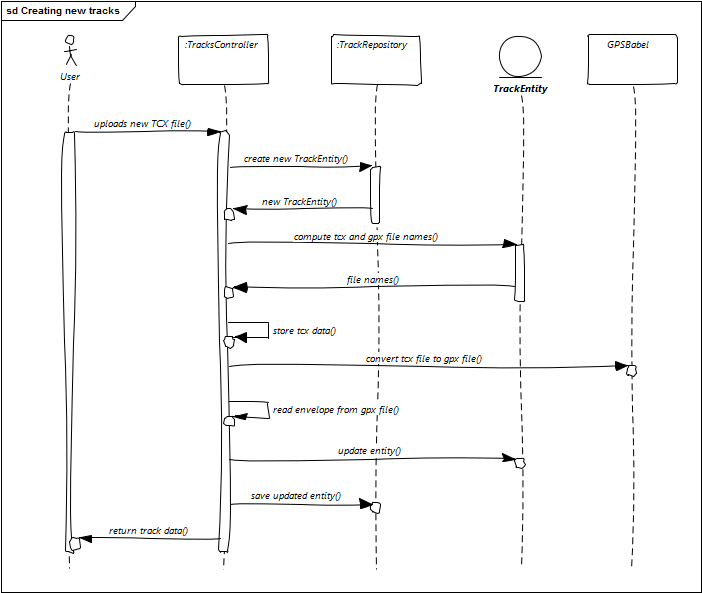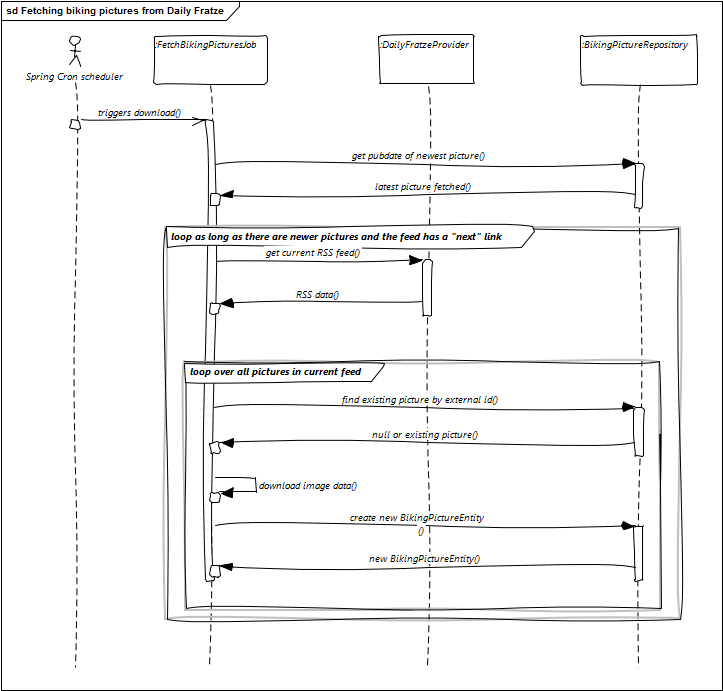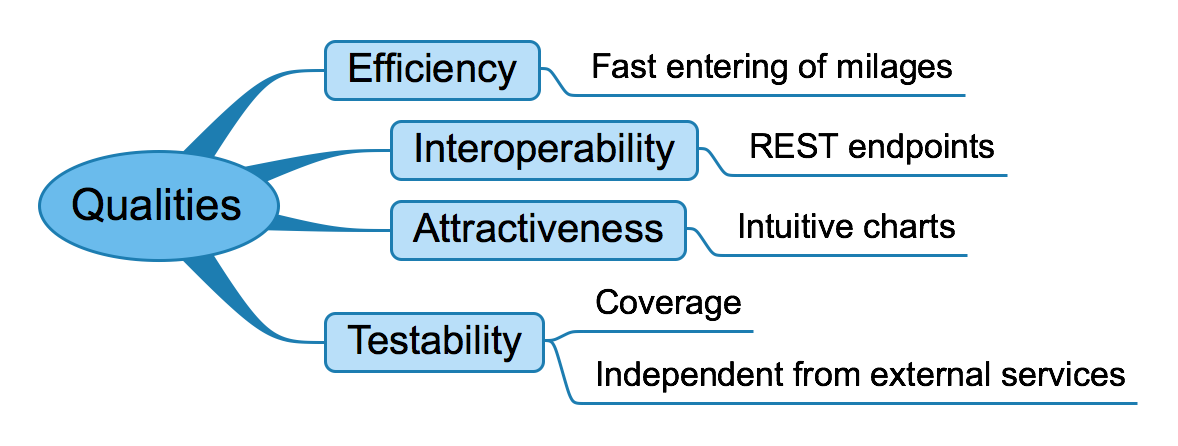Disclaimer
I provide absolutely no guarantee, neither for the accuracy of this documentation nor for any property or feature of the software described here.
Do not use this software in critical situations or projects.
1. Introduction and Goals
biking.michael-simons.eu is a project for
-
tracking my bike activities
-
evaluating technology
-
learn stuff
-
showcasing my skills
For my information see this blog post as a starting point.
I’d like to thank all the people working at the Spring Eco System for doing their amazing work. Also a big thank you to Dr. Gernot Starke and Dr. Peter Hruschka for their inspiring workshop "Mastering Software Architecture" in Munich, December 2015. I took not only a nice CPSA-F certificate home, but really valuable and practical patterns for improving "my" software.
The blog post above had song lyrics from Nick Cave & The Bad Seeds as intro (from “Push The Sky Away”) and for the architecture i have this:
Simplicity is a great virtue but it requires hard work to achieve it and education to appreciate it. And to make matters worse: complexity sells better.
On the nature of Computing Science
1.1. Requirements Overview
The main purpose of biking2 is keeping track of bicycles and their milages as well as converting Garmin Training Center XML (tcx) files to standard GPS Exchange Format (GPX) files and storing them in an accessible way.
In addition biking2 is used to study and evaluate technology, patterns and frameworks. The functional requirements are simple enough to leave enough room for concentration on quality goals.
-
Store bikes and their milages
-
Convert tcx files to GPX files and provide them in a library of tracks
-
Visualize those tracks on a map and provide a way to embed them in other webpages
-
Visualize biking activities with images
-
Optional, near real time, tracking of a biker
The application must only handle exactly one user with write permissions.
Most bike aficionados have problems understanding the question "why more than one bike?", the system should be able to keep track of everything between 2 and 10 bikes for one user, storing 1 total milage per bike and month. All milages per month, year and other metrics should be derived from this running total, so that the user only need to look at his odometer and enter the value.
The application should store an "unlimited" number of tracks.
The images should be collected from Daily Fratze, the source are all images that are tagged with "Radtour". In addition the user should be able to provide an "unlimited" number of "gallery pictures" together with a date and a short description.
1.2. Quality Goals
| Nr. | Quality | Motivation |
|---|---|---|
1 |
Understandability |
The functional requirements are simple enough to allow a simple, understandable solution that allows focus on learning about new Java 8 features, Spring Boot and AngularJS. |
2 |
Efficiency |
Collecting milage data should be a no brainer: Reading the milage from an odometer and entering it. |
3 |
Interoperability |
The application should provide a simple API that allows access to new clients. |
4 |
Attractiveness |
Collected milages should be presented in easy to grasp charts. |
5 |
Testability |
The architecture should allow easy testing of all main building blocks. |
1.3. Stakeholders
The following lists contains the most important personas for this application
| Role/Name | Goal/Boundaries |
|---|---|
Developers |
Developers who want to learn about developing modern applications with Spring Boot and various frontends, preferable using Java 8 in the backend. |
Bikers |
Bike aficionados that are looking for a non-excel, self-hosted solution to keep track of their bikes and milages. |
Software Architects |
Looking for an arc42 example; want to get ideas for their daily work. |
Michael Simons |
Improving his skills; wants to blog about Spring Boot; looking for a topic he can eventually hold a talk about; needed a project to try out new Java 8 features. |
2. Architecture Constraints
The few constraints on this project are reflected in the final solution. This section shows them and if applicable, their motivation.
2.1. Technical Constraints
| Constraint | Background and / or motivation | |
|---|---|---|
Software and programming constraints |
||
TC1 |
Implementation in Java |
The application should be part of a Java 8 and Spring Boot show case. The interface (i.e. the api) should be language and framework agnostic, however. It should be possible that clients can be implemented using various frameworks and languages.. |
TC2 |
Third party software must be available under an compatible open source license and installable via a package manager |
The interested developer or architect should be able to check out the sources, compile and run the application without problems compiling or installing dependencies. All external dependencies should be available via the package manager of the operation system or at least through an installer. |
Operating System Constraints |
||
TC3 |
OS independent development |
The application should be compilable on all 3 mayor operation systems (Mac OS X, Linux and Windows) |
TC4 |
Deployable to a Linux server |
The application should be deployable through standard means on a Linux based server |
Hardware Constraints |
||
TC5 |
Memory friendly |
Memory can be limited (due to availability on a shared host or deployment to cloud based host). If deployed to a cloud based solution, every megabyte of memory costs. |
2.2. Organizational Constraints
| Constraint | Background and / or motivation | |
|---|---|---|
OC1 |
Team |
Michael Simons |
OC2 |
Time schedule |
Start in early 2014 with Spring Boot beta based prototypes running on Java 8 early access builds, first "release" version March 2014 together with the initial release of Java 8. Upgrade to a final Spring Boot release when they are available. |
OC3 |
IDE independent project setup |
No need to continue the editor and IDE wars. The project must be compilable on the command line via standard build tools. Due to OC2 there is only one IDE supporting Java 8 features out of the box: NetBeans 8 beta and release candidates. |
OC4 |
Configuration and version control / management |
Private git repository with a complete commit history and a public master branch pushed to GitHub and linked a project blog. |
OC5 |
Testing |
Use JUnit to prove functional correctness and integration tests and JaCoCo to ensure a high test coverage (at least 90%). |
OC6 |
Published under an Open Source license |
The source, including documentation, should be published as Open Source under the Apache 2 License. |
2.3. Conventions
| Conventions | Background and / or motivation | |
|---|---|---|
C1 |
Architecture documentation |
Structure based on the english arc42-Template in version 6.5 |
C2 |
Coding conventions |
The project uses the Code Conventions for the Java TM Programming Language. The conventions are enforced through Checkstyle. |
C3 |
Language |
English. The project and the corresponding blog targets an international audience, so English should be used throughout the whole project. |
C4 |
Naming conventions |
There are some naming conventions listed below that are checked and enforced with jQAssistant |
The following naming conventions are used throughout the project:
ac.simons.MATCH
(project:Maven:Project)-[:CREATES]->(:Artifact)-[:CONTAINS]->(type:Type)
WHERE
NOT type.fqn starts with 'ac.simons'
RETURN
project as Project, collect(type) as TypeWithWrongNameMATCH
(project:Maven:Project)-[:CREATES]->(:Artifact)-[:CONTAINS]->(type:Type)
WHERE
NOT type.fqn contains project.artifactId
RETURN
project as Project, collect(type) as TypeWithWrongName@Entity must have a name that ends with the suffix Entity.MATCH
(t:Jpa:Entity)
WHERE
NOT t.name ends with "Entity"
RETURN
t as EntityRepository.MATCH
(t:Repository)
WHERE t:Java
AND NOT t.name ends with "Repository"
RETURN
t as Repository3. System Scope and Context
This chapter describes the environment and context of biking2: Who uses the system and on which other system does biking2 depend.
3.1. Business Context
.png)
A passionate biker uses biking2 to manage his bikes, milages, tracks and also visual memories (aka images) taken on tours etc. He also wants to embed his tracks as interactive maps on other websites.
Daily Fratze provides a list of images tagged with certain topics. biking2 should collect all images for a given user tagged with "Theme/Radtour".
GPSBabel is a command line utility for manipulating GPS related files in various ways. biking2 uses it to convert TCX into GPX files. The heaving lifting is done by GPSBabel and the resulting file will be managed by biking2.
The user may want to embed (or brag with) tracks on arbitrary websites. He only wants to paste a link to a track on a website that supports embedded content to embed a map with the given track.
3.2. Technical Context
.png)
biking2 is broken into 2 main components:
The api runs on a supported application server, using either an embedded container or an external container. It communicates via operating system processes with GPSBabel on the same server.
The connection to Daily Fratze is http based RSS-feed. The feed is paginated and provides all images with a given tag but older images may not be available any more when the owner decided to add a digital expiry.
Furthermore biking2 provides an oEmbed interface for all tracks stored in the system. Arbitrary websites supporting that protocol can request embeddable content over http knowing only a link to the track without working on the track or map apis themselves.
The frontend is implemented with two different components, the biking2::spa (Single Page Application) is part of this package. The spa runs in any modern web browser and communicates via http with the api.
| Business interface | channel |
|---|---|
Format conversions |
System processes, command line interface |
Collection of biking pictures |
RSS feed over Internet (http) |
Embeddable content |
oEmbed format over Internet (http) |
API for business functions |
Internet (http) |
4. Solution Strategy
At the core of biking2 is a simple yet powerful domain model based on a few entities of which a "Bike" and it’s "Milage" are the most important.
Although data centric, the application resigns from using too much SQL for creating reports, summaries and such but tries to achieve that with new Java 8 features around streams, lambdas and map/reduce functions.
Building the application with Spring Boot is an obvious choice as one of the main quality goals is learning about it. But furthermore using Spring Boot as a "framework" for Spring Framework allows concentration on the business logic. On the one hand there is no need to understand a complex XML configuration and on the other hand all building blocks are still put together using dependency injection.
Regarding dependency injection and testability: All injection should be done via constructor injection, setter injection is only allowed when there’s no other technical way. This way units under tests can only be correctly instantiated. Otherwise one tends to forget collaborators or even worse: 20 injected attributes may not hurt, but a constructor with 20 parameters will. This hopefully prevents centralized "god classes" that control pretty much every other aspect of the application.
Spring Boot applications can be packaged as single, "fat jar" files. Since Spring Boot 1.3 those files contain a startup script and can be directly linked to /etc/init.d on a standard Linux systems which serves [TC4].
Interoperability will be achieved by using JSON over simple http protocol for the main API. Security is not the main focus of this application. It should be secure enough to prevent others from tempering with the data, confidentiality is not a main concern (read: passwords can be transmitted in plain over http).
The internal single page application shall be implemented using AngularJS. The deployable artifact will contain this application so there is no need for hosting a second webserver for the static files.
For real time tracking the MQTT protocol will be used which is part of Apache ActiveMQ, supported out of the box by Spring Messaging.
Graphing should not be implemented here but instead the Highcharts library should be used. The configuration for all charts should be computed server side.
| The original installment of this project used Java 8 streams and api heavily to compute statistics (everything under https://biking.michael-simons.eu/milages). Back in 2014 and 2015, when Java 8 was new, it helped a lot to learn that API. Nearly 5 years later, thinking about my history with database and looking at a tons of talk about SQL I gave, I decided it was time to go back to my roots. All the charts are now created with a dedicated statistics service, that is based on jOOQ and typesafe SQL. |
5. Building Block View
The application packaged as biking2.jar contains two (the api and the spa) of three main parts, as shown in the Business Context:
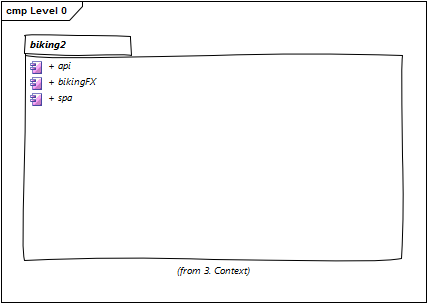
From those two we have a closer look at the api only. For details regarding the structure of an AngularJS 1.2.x application, have a look at their developers guide.
| To comply with the Java coding style guidelines, the modules "bikingPictures" and "galleryPictures" reside in the Java packages "bikingpictures" and "gallerypictures". |
5.1. Whitebox biking2::api
The following diagram shows the main building blocks of the system and their interdependencies:
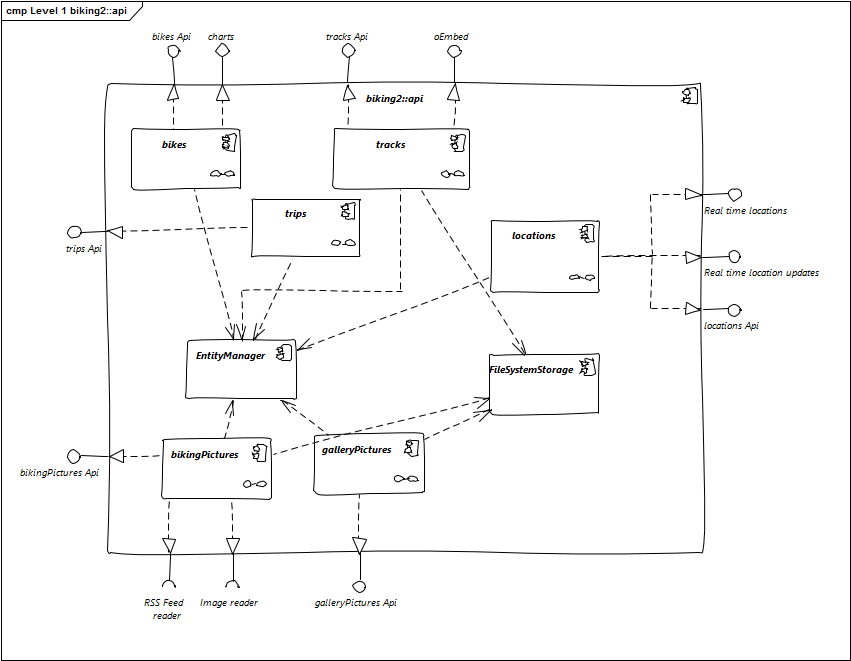
I used functional decomposition to separate responsibilities. The single parts of the api are all encapsulated in their own components, represented as Java packages.
All components depend on a standard JPA EntityManager and some on local file storage. I won’t go into detail for those blackboxes.
- Contained blackboxes
Managing bikes, adding monthly milages, computing statistics and generating charts. |
|
Uploading tracks (TCX files), converting to GPX, providing an oEmbed interface. |
|
Managing assorted trips. |
|
MQTT and STOMP interface for creating new locations and providing them in real time on websockets via stomp. |
|
Reading biking pictures from an RSS feed provided by Daily Fratze and providing an API to them. |
|
Uploading and managing arbitrary pictures |
|
Provides an API for statistics |
All the blackboxes above should correspond to Java packages. Those packages should have no dependencies to other packages outside themselves but for the support or shared package:
MATCH (db:Package:Database)
WITH db
MATCH (a:Main:Artifact)
MATCH (a) -[:CONTAINS]-> (p1:Package) -[:DEPENDS_ON]-> (p2:Package) <-[:CONTAINS]- (a)
WHERE not p1:Config
and not (p1) -[:CONTAINS]-> (p2)
and not p2:Support
and p2 <> db
and not (db) - [:CONTAINS*] -> (p2)
RETURN p1, p2Additional configuration apart from properties lives in the config package:
MATCH (p:Package)
WHERE p.fqn in ['ac.simons.biking2.config']
SET p:Package:Config
return pThe support package contains technical infrastructure classes while the shared package contains application wide messages. Those packages are used as supporting packages:
MATCH (p:Package)
WHERE p.fqn in ['ac.simons.biking2.shared', 'ac.simons.biking2.support']
SET p:Package:Support
return pThe database package contains generated code for accessing our database via jOOQ:
MATCH (p:Package)
WHERE p.fqn in ['ac.simons.biking2.db']
SET p:Package:Database
return p- Interfaces
| Interface | Description |
|---|---|
bikes Api |
REST api containing methods for reading, adding and decommissioning bikes and for adding milages to single bikes. |
charts |
Methods for retrieving statistics as fully setup chart definitions. |
tracks Api |
REST api for uploading and reading TCX files. |
trips Api |
REST api for adding new trips. |
oEmbed |
HTTP based oEmbed interface, generating URLs with embeddable content. |
Real time locations |
WebSocket / STOMP based interface on which new locations are published. |
Real time location updates |
MQTT interface to which MQTT compatible systems like OwnTracks can offer location updates. |
RSS feed reader |
Needs an Daily Fratze OAuth token for accessing a RSS feed containing biking pictures which are than grabbed from Daily Fratze. |
galleryPictures Api |
REST api for uploading and reading arbitrary image files (pictures related to biking). |
5.1.1. bikes (Blackbox)
- Intent/Responsibility
-
bikesprovides the external API for reading, creating and manipulating bikes and their milages as well as computing statistics and generating charts. - Interfaces
| Interface | Description |
|---|---|
REST interface |
Contains all methods for manipulating bikes and their milages. |
REST interface |
Contains all methods for generating charts. |
- Files
-
The
bikesmodule and all of its dependencies are contained inside the Java packageac.simons.biking2.bikes.
5.1.2. tracks (Blackbox)
- Intent/Responsibility
-
tracksmanages file uploads (TCX files), converts them to GPX files and computes their surrounding rectangle (envelope) using GPSBabel. It also provides the oEmbed interface that resolves URLS to embeddable tracks. - Interfaces
| Interface | Description |
|---|---|
REST interface |
Contains all methods for manipulating tracks. |
|
Resolve track URLs to embeddable tracks (content). |
|
Embeddable track content. |
- Files
-
The
tracksmodule and all of its dependencies are contained inside the Java packageac.simons.biking2.tracks.
5.1.3. trips (Blackbox)
- Intent/Responsibility
-
tripsmanages distances that have been covered on single days without relationships to bikes. - Interfaces
| Interface | Description |
|---|---|
REST interface |
Contains all methods for manipulating trips. |
- Files
-
The
tripsmodule and all of its dependencies are contained inside the Java packageac.simons.biking2.trips.
5.1.4. locations (Blackbox)
- Intent/Responsibility
-
locationsstores locations with timestamps in near realtime and provides access to locations for the last 30 minutes. - Interfaces
| Interface | Description |
|---|---|
REST interface |
For retrieving all locations in the last 30 minutes. |
WebSocket / STOMP topic |
Interface for getting notifcation on new locations. |
MQTT interface |
Listens for new locations coming in via MQTT in OwnTracks format. |
- Files
-
The
locationsmodule and all of its dependencies are contained inside the Java packageac.simons.biking2.tracker. The module is configured throughac.simons.biking2.config.TrackerConfig.
5.1.5. bikingPictures (Blackbox)
- Intent/Responsibility
-
bikingPicturesis used for regularly checking a RSS feed from Daily Fratze collecting new images and storing them locally. It also provides an API for getting all collected images. - Interfaces
| Interface | Description |
|---|---|
RSS Feed reader |
Provides access to the Daily Fratze RSS Feed. |
Image reader |
Provides access to images hosted on Daily Fratze. |
REST interface |
Contains all methods for accessing biking pictures. |
- Files
-
The
bikingPicturesmodule and all of its dependencies are contained inside the Java packageac.simons.biking2.bikingpictures.
5.1.6. galleryPictures (Blackbox)
- Intent/Responsibility
-
galleryPicturesmanages file uploads (images). It stores them locally and provides an RSS interface for getting metadata and image data. - Interfaces
| Interface | Description |
|---|---|
REST interface |
Contains all methods for adding and reading arbitrary pictures. |
5.1.7. statistics (Blackbox)
- Intent/Responsibility
-
Module for computing statistics, generating charts and providing version and summary information.
- Interfaces
| Interface | Description |
|---|---|
REST interface |
Contains all methods for generating Highcharts Charts. |
REST interface |
Aggregated values. |
- Files
-
The
statisticsmodule and all of its dependencies are contained inside the Java packageac.simons.biking2.statistics.
5.2. Building Blocks - Level 2
5.2.1. bikes (Whitebox)
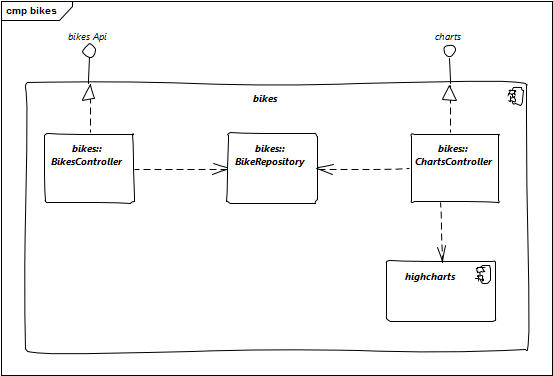
The BikeRepository is a Spring Data JPA based repository for BikeEntities. The BikeController and the ChartsController access it to retrieve and store instances of BikeEntity and provide external interfaces.
- Contained blackboxes
highcharts |
Contains logic for generating configurations and definitions for Highcharts on the server side. |
5.2.2. tracks (Whitebox)
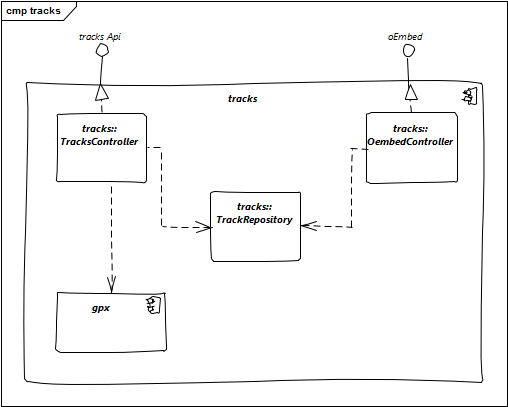
The TrackRepository is a Spring Data JPA based repository for TrackEntities. The TracksController and the OembedController access it to retrieve and store instances of TrackEntity and provide external interfaces.
- Contained blackboxes
gpx |
Generated JAXB classes for parsing GPX files. Used by the |
5.2.3. trips (Whitebox)
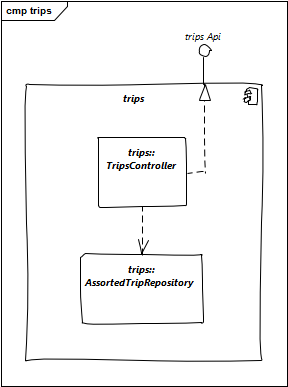
The AssortedTripRepository is a Spring Data JPA based repository for AssortedTripEntities. The TripsController accesses it to retrieve and store instances of TrackEntity and provide external interfaces.
5.2.4. locations (Whitebox)
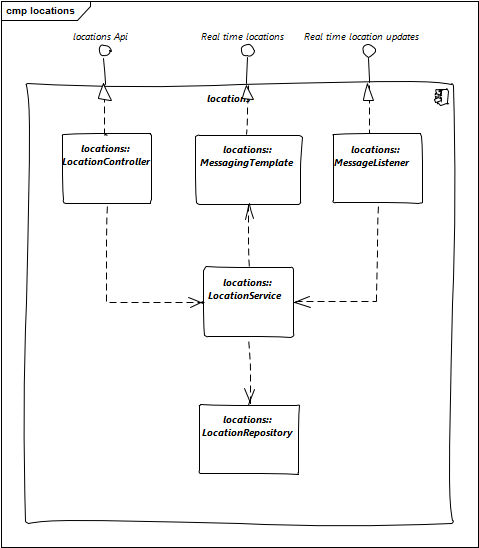
Locations are stored and read via a Spring Data JPA based repository named LocationRepository. This repository is only accessed through the LocationService. The LocationService provides real time updates for connected clients through a SimpMessagingTemplate and the LocationController uses the service to provide access to all locations created within the last 30 minutes.
New locations are created by the service either through a REST interface in form of the LocationController or via a MessageListener on a MQTT channel.
5.2.5. bikingPictures (Whitebox)
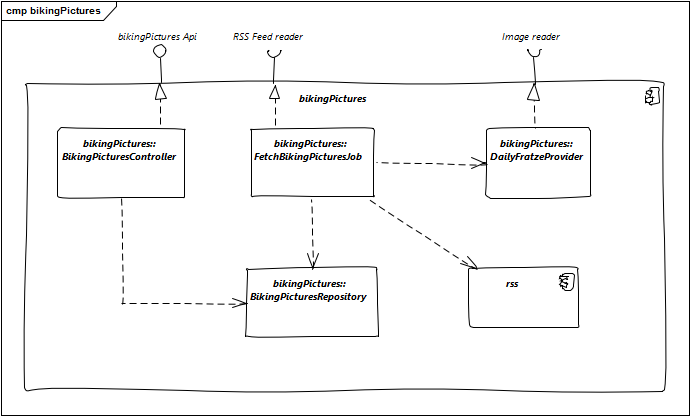
A Spring Data JPA repository named BikingPicturesRepository is used for all access to BikingPictureEntities, the external REST api for reading pictures is implemented with BikingPicturesController. The RSS feed is read from FetchBikingPicturesJob by using a JAXBContext "rss". The URLs to the image files which may are protected by various means are provided to the job via a DailyFratzeProvider.
- Contained blackboxes
rss |
Generated JAXB classes for parsing RSS feeds. Used by the |
5.2.6. galleryPictures (Whitebox)
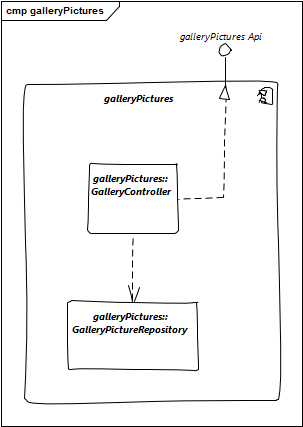
The GalleryPictureRepository is a Spring Data JPA based repository for GalleryPictureEntities. The GalleryController accesses it to retrieve and store instances of GalleryPictureEntity and provide external interfaces.
5.2.7. statistics (Whitebox)
The StatisticService is a database centric service that uses an instance of jOOQ’s DSLContext for creating SQL.
That SQL is not generated SQL, but handcrafted.
jOOQ is used only to do this in a types safe way.
During build, jOOQ reads a temporary database, created from SQL based migration scripts, and provides several Java classes reassembling a schema. Those classes along with the DSL are used to write SQL.
The statements make heavily use of analytic functions. This is necessary, as the original decision for storing milages has been not storing the amount biked each month, but the accumulated milage on a bike. Therefore, the monthly values need to be computed.
This is done by queries like the following
WITH mm AS (
SELECT
bikes.name,
bikes.color,
milages.recorded_on,
(lead(milages.amount) OVER (PARTITION BY bikes.id ORDER BY milages.recorded_on) - milages.amount) value
FROM bikes
JOIN milages
ON milages.bike_id = bikes.id
ORDER BY milages.recorded_on ASC
)
SELECT
mm.name,
mm.color,
(EXTRACT(MONTH FROM mm.recorded_on) - 1) idx,
mm.value,
sum(mm.value) OVER (PARTITION BY mm.recorded_on) total
FROM mm
WHERE (
mm.value IS NOT NULL
AND EXTRACT(YEAR FROM mm.recorded_on) >= EXTRACT(YEAR FROM DATE '2019-01-01')
)
ORDER BY mm.name ASC6. Runtime View
User interaction with biking2 and error handling is pretty basic and simple.
I picked up two uses cases where an actual runtime view is interesting:
7. Deployment View

| Node / artifact | Description |
|---|---|
biking2 development |
Where biking2 development takes place, standard computer with JDK 8, Maven and GPSBabel installed. |
uberspace host |
A host on Uberspace where biking2.jar runs inside a Server JRE with restricted memory usage. |
biking2.jar |
A "fat jar" containing all Java dependencies and a loader so that the Jar is runnable either as jar file or as a service script (on Linux hosts). |
Browser |
A recent browser to access the AngularJS biking2 single page application. All major browsers (Chrome, Firefox, Safari, IE / Edge) should work. |
8. Concepts
8.1. Domain Models
biking2 is a datacentric application, therefore everything is based around an Entity Relationship Diagram (ER-Diagram):

| Name | Description |
|---|---|
bikes |
Stores the bikes. Contains dates when the bike was bought and decomissioned, an optional link, color for the charts and also an auditing column when a row was created. |
milages |
Stores milages for a bike (when and how much). |
tracks |
Stores GPS tracks recorded and uploaded with an optional description. For each day the track names must be unique. The columns minlat, minlon, maxlat and maxlon store the encapsulating rectangle for the track. The type column is constrainted to "biking" and "running". |
assorted_trips |
Stores a date and a distance on that day. Multiple distances per day are allowed. |
locations |
Stores arbitrary locations (latitude and longitude based) for given timestamp with an optional description. |
biking_pictures |
Stores pictures collected from Daily Fratze together with their original date of publication, their unique external id and a link to the page the picture originaly appeared. |
gallery_pictures |
Stores all pictures uploaded by the user with a description and the date the picture was taken. The filename column contains a single, computed filename without path information. |
Those tables are mapped to the following domain model:

| Name | Description |
|---|---|
BikeEntity |
A bike was bought on a given date and can be decommisioned. It has a color and an optional link to an arbitrary website. It may or may not have milages recorded. It has some important functions, see Important business methods on BikeEntity |
MilageEntity |
A milage is part of a bike. For each bike one milage per month can be recored. The milage is the combination of it’s recording date, the amount and the bike. |
TrackEntity |
The representation of tracks contents. The type is an enumeration. Notable public operations are |
BikingPictureEntity |
For handling pictures collected from Daily Fratze. The BikingPictureEntity parses the image link on construction and retrieves the unique, external id. |
GalleryPictureEntity |
A bean for handling the pictures uploaded by the user. |
AssortedTripEntity |
This entity captures a distance which was covered on a certain date and can used for keeping track of trips with bikes not stored in this application for example. |
LocationEntity |
Used in the tracker module for working with real time locations. |
| Name | Description |
|---|---|
|
Decommissions a bike on a given date. |
|
Adds a new milage for a given date and returns it. The milage will only be added if the date is after the date the last milage was added and if the amount is greater than the last milage. |
|
Gets all monthly periods in which milages have been recorded. |
|
Gets the total milage of this bike. |
|
Gets the last milage recorded. In most cases the same as |
|
Gets the milage in a given period. |
|
Gets all milages in a year as an array (of months). |
|
Gets the total milage in a given year. |
8.2. Persistency
biking2 uses an H2 database for storing relational data and the file system for binary image files and large ascii files (especially all GPS files).
During development and production the H2 database is retained and not in-memory based. The location of this file is configured through the biking2.database-file property and the default value during development is ./var/dev/db/biking-dev relative to the working directory of the VM.
All access to the database goes through JPA using Hibernate as provider. See the Domain Models for all entities used in the application.
The JPA Entity Manager isn’t accessed directly but only through the facilities offered by Spring Data JPA, that is through repositories only.
All data stored as files is stored relative to biking2.datastore-base-directory which defaults to ./var/dev. Inside are 3 directories:
-
bikingPictures: Contains all pictures collected from Daily Fratze -
galleryPictures: Contains all uploaded pictures -
tracks: Contains uploaded GPS data and the result of converting TCX files into GPX files
8.3. User Interface
The default user interface for biking2 which is packaged within the final artifact is a Single Page Application written in JavaScript using Angular JS together with a very default Bootstrap template.
For using the realtime location update interface, choose one of the many MQTT clients out there.
There is a second user interface written in Java called bikingFX.
8.4. JavaScript and CSS optimization
JavaScript and CSS dependencies are managed through Maven dependencies in form of webjars wherever possible without the need for brew, npm, bower and the like.
Furthermore biking2 uses wro4j together with a small Spring Boot Starter to optimize JavaScript and CSS web resources.
wro4j provides a model like this:
<groups xmlns="http://www.isdc.ro/wro">
<!-- Dependencies for the full site -->
<group name="biking2">
<group-ref>osm</group-ref>
<css minimize="false">/webjars/bootstrap/@bootstrap.version@/css/bootstrap.min.css</css>
<css>/css/icons.css</css>
<css>/css/stylesheet.css</css>
<js minimize="false">/webjars/jquery/@jquery.version@/jquery.min.js</js>
<js minimize="false">/webjars/bootstrap/@bootstrap.version@/js/bootstrap.min.js</js>
<js minimize="false">/webjars/momentjs/@momentjs.version@/min/moment-with-locales.min.js</js>
<js minimize="false">/webjars/angular-file-upload/@angular-file-upload.version@/angular-file-upload-html5-shim.min.js</js>
<js minimize="false">/webjars/angularjs/@angularjs.version@/angular.min.js</js>
<js minimize="false">/webjars/angularjs/@angularjs.version@/angular-route.min.js</js>
<js minimize="false">/webjars/angularjs/@angularjs.version@/angular-sanitize.min.js</js>
<js minimize="false">/webjars/angular-file-upload/@angular-file-upload.version@/angular-file-upload.min.js</js>
<js minimize="false">/webjars/angular-ui-bootstrap/@angular-ui-bootstrap.version@/ui-bootstrap.min.js</js>
<js minimize="false">/webjars/angular-ui-bootstrap/@angular-ui-bootstrap.version@/ui-bootstrap-tpls.min.js</js>
<js minimize="false">/webjars/highcharts/@highcharts.version@/highcharts.js</js>
<js minimize="false">/webjars/highcharts/@highcharts.version@/highcharts-more.js</js>
<js minimize="false">/webjars/sockjs-client/@sockjs-client.version@/sockjs.min.js</js>
<js minimize="false">/webjars/stomp-websocket/@stomp-websocket.version@/stomp.min.js</js>
<js>/js/ansi_up.js</js>
<js>/js/app.js</js>
<js>/js/controllers.js</js>
<js>/js/directives.js</js>
</group>
</groups>This model file is filtered by the Maven build, version placeholders will be replaced and all resources, in webjars as well as inside the filesystem, will be available as biking.css and biking.js.
How those files are optimized, minimized or otherwise processed is up to wro4js configuration, but minification can be turned off during development.
8.5. Transaction Processing
biking2 relies on Spring Boot to create all necessary beans for handling local transactions within the JPA EntityManager. biking2 does not support distributed transactions.
8.6. Session Handling
biking2 only provides a stateless public API, there is no session handling.
8.7. Security
biking2 offers security for its API endpoints only via HTTP basic access authentication and in case of the MQTT module with MQTTs default security model. Security can be increased by running the application behind a SSL proxy or configuring SSL support in the embedded Tomcat container.
For the kind of data managed here it’s an agreed tradeoff to keep the application simple. See also Safety.
8.8. Safety
No part of the system has life endangering aspect.
8.9. Communications and Integration
biking2 uses an internal Apache ActiveMQ broker on the same VM as the application for providing STOMP channels and a MQTT transport. This broker is volatile, messages are not persisted during application restarts.
8.10. Plausibility and Validity Checks
Datatypes and ranges are checked via JSR-303 annotations on classes representing the Domain Models. Those classes are directly bound to external REST interfaces.
There are three important business checks:
-
Bikes which have been decommissioned cannot be modified (i.e. they can have no new milages): Checked in
BikesController. -
For each unique month only one milage can be added to a bike. Checked in the
BikeEntity. -
A new milage must be greater than the last one. Also checked inside
BikeEntity.
8.11. Exception/Error Handling
Errors handling to inconsistent data (in regard to the data models constraint) as well as failures to validation are mapped to HTTP errors. Those errors are handled by the frontends controller code. Technical errors (hardware, database etc.) are not handled and may lead to application failure or lost data.
8.12. Logging, Tracing
Spring Boot configures logging per default to standard out. The default configuration isn’t change in that regard, so all framework logging (especially Spring and Hiberate) go to standard out in standard format and can be grabbed or ignored via OS specific means.
All business components use the Simple Logging Facade for Java (SLF4J). The actual configuration of logging is configured through the means of Spring Boot. No special implementation is included manually, instead biking2 depends transitively on spring-boot-starter-logging.
The names of the logger corresponds with the package names of the classes which instantiate loggers, so the modules are immediately recognizable in the logs.
8.13. Configurability
Spring Boot offers a plethora of configuration options, those are just the main options to configure Spring Boot and available starters: Common application properties.
The default configuration is available in src/main/resources/application.properties. During development those properties are merged with src/main/resources/application-dev.properties. Additional properties can be added through system environment or through an application-*.properties in the current JVM directory.
During tests an additional application-test.properties can be used to add or overwrite additional properties or values.
Those are the biking2 specific properties:
| Property | Default | Description |
|---|---|---|
biking2.color-of-cumulative-graph |
000000 |
Color of the cumulative line graph |
biking2.dailyfratze-access-token |
n/a |
An OAuth access token for Daily Fratze |
biking2.datastore-base-directory |
${user.dir}/var/dev |
Directory for storing files (tracks and images) |
biking2.fetch-biking-picture-cron |
0 0 */8 * * * |
A cron expression for configuring the |
biking2.home.longitude |
6.179489185520004 |
Longitude of the home coordinate |
biking2.home.latitude |
50.75144902272457 |
Latitude of the home coordinate |
biking2.connector.proxyName |
n/a |
The name of a proxy if biking2 runs behind one |
biking2.connector.proxyPort |
80 |
The port of a proxy if biking2 runs behind one |
biking2.gpsBabel |
/opt/local/bin/gpsbabel |
Fully qualified path to the GPSBabel binary |
biking2.scheduled-thread-pool-size |
10 |
Thread pool size for the job pool |
biking2.tracker.host |
localhost |
The host on which the tracker (MQTT channel) should listen |
biking2.tracker.stompPort |
2307 |
STOMP port |
biking2.tracker.mqttPort |
4711 |
MQTT port |
biking2.tracker.username |
${security.user.name} |
Username for the MQTT channel |
biking2.tracker.password |
${security.user.password} |
Password for the MQTT channel |
biking2.tracker.device |
iPhone |
Name of the OwnTracks device |
8.14. Internationalization
Only supported language is English. There is no hook for doing internationalization in the frontend and there are no plans for creating one.
8.15. Migration
biking2 replaced a Ruby application based on the Sinatra framework. Data was stored in a SQLite database which has been migrated by hand to the H2 database.
8.16. Testability
The project contains JUnit tests in the standard location of a Maven project. At the time of writing those tests covers >95% of the code written. Tests must be executed during build and should not be skipped.
8.17. Build-Management
The application can be build with Maven without external dependencies outside Maven. gpsbabel must be on the path to run all tests, though.
9. Design Decisions
9.1. Using GPSBabel for converting TCX into GPX format
Popular JavaScript mapping frameworks provide easy ways to include geometries from GPX data on maps. Most Garmin devices however record track data in TCX format, so I needed a way to convert TCX to GPX. Both formats are relatively simple and in case of GPX good documented formats.
-
Conversion should handle TCX files with single tracks, laps and additional points without problem
-
Focus for this project has been on developing a modern application backend for an AngularJS SPA, not parsing GPX data
-
Using an external, non Java based tool makes it harder for people who just want to try out this application
-
Although good documented, both file types can contain varieties for informations (routes, tracks, waypoints) which makes it hard to parse
-
Writing my own converter
-
Using existing swiss army knife for GPS data: GPSBabel
GPSBabel converts waypoints, tracks, and routes between popular GPS receivers such as Garmin or Magellan and mapping programs like Google Earth or Basecamp. Literally hundreds of GPS receivers and programs are supported. It also has powerful manipulation tools for such data. such as filtering duplicates points or simplifying tracks. It has been downloaded and used tens of millions of times since it was first created in 2001, so it’s stable and trusted.
biking2 uses GPSBabel for the heavy lifting of GPS related data. The project contains a README stating that GPSBabel must be installed. GPSBabel can be installed on Windows with an installer and on most Linux systems through the official packet manager. Under OS X it is available via MacPorts or Homebrew.
9.2. Using local file storage for image and track data
biking2 needs to store "large" objects: Image data (biking and gallery pictures) as well as track data.
-
Using some kind of Cloud storage like S3
-
Using local file system
I opted for local file system because I didn’t want to put much effort into evaluating cloud services. If biking2 should runnable in cloud based setup, one has to create an abstraction over the local filesystem currently used.
9.3. Use a database centric approach
biking2 was not received as database centric in the beginning. Hibernate entities had been modelled, the database was setup with Hibernates automatic DDL. Analytic functions had not been used, but computation has been done in memory.
Use a database centric approach as described in "Live with your SQL-fetish and choose the right tool for the job"
In late 2019, that decision has been implemented. Flyway has been introduced to create tables and other migrations via SQL scripts. Based on a database that is actually under our control, we generate a jOOQ schema, on which all SQL generation for computing statistics is done. For more information, have a look at the whitebox view of the statistics modul.
10. Quality Scenarios
10.2. Evaluation Scenarios
By using JaCoCo during development and the build process ensure a code coverage of at least 95%.
The architecture should be designed in such a way that algorithms depending on external services can be tested without having the external service available. That is: All external dependencies should be mockable.
Example: FetchBikingPicturesJob needs a resource containing a RSS feed. Retrieving the resource and parsing it are at least two different tasks. Fetching the resource through a separate class DailyFratzeProvider makes testing the actual parsing independent from a HTTP connection and thus relatively simple.
11. Technical Risks
biking2 has been up and running for nearly 2 years now, the architecture contains no known risk for my usage scenario.
There is a possibility that the H2 database can be damaged due to an unexpected shutdown of the VM (that is OS or hardware failure). The risk is mitigated through regularly backups of the serialized database file.
12. Glossary
| Term | Synonym(s) | Description |
|---|---|---|
AngularJS |
AngularJS is an open-source web application framework mainly maintained by Google and by a community of individual developers and corporations to address many of the challenges encountered in developing single-page applications. |
|
Apache ActiveMQ |
Apache ActiveMQ is an open source message broker written in Java. |
|
Apache License |
The Apache License is a permissive Open Source license, especially designed for free software. |
|
Bootstrap |
Bootstrap is the most popular HTML, CSS, and JS framework for developing responsive, mobile first projects on the web. |
|
Checkstyle |
Checkstyle is a development tool to help programmers write Java code that adheres to a coding standard. It automates the process of checking Java code to spare humans of this boring (but important) task. This makes it ideal for projects that want to enforce a coding standard. |
|
Daily Fratze |
df, DF, DailyFratze |
An online community where users can upload a daily picture of themselves (a selfie, but the site did them before they where called selfies). |
Fat Jar |
A way of packaging Java applications into one single Jar file containing all dependencies, either repackaged or inside their original jars together with a special class loader. |
|
Flyway |
Flyway is a SQL centric tool for applying database migrations in a controlled fashion. |
|
Gallery picture |
Pictures from tours provided manually by the hours in addition to the pictures collected automatically from Daily Fratze. |
|
Garmin |
Garmin develops consumer, aviation, outdoor, fitness, and marine technologies for the Global Positioning System. |
|
GPSBabel |
GPSBabel is a command line utility that converts waypoints, tracks, and routes between popular GPS receivers such as Garmin or Magellan and mapping programs like Google Earth or Basecamp. |
|
GPX |
GPS Exchange Format |
GPX, or GPS Exchange Format, is an XML schema designed as a common GPS data format for software applications. It can be used to describe waypoints, tracks, and routes. |
JaCoCo |
JaCoCo is a code coverage library which can be used very easily from within NetBeans. |
|
Java 8 |
JDK 8 |
The eight installment of the Java programming language and the first one to support functional paradigms in the form Lambda expressions. |
jOOQ |
Java Object oriented querying: jOOQ is a framework for writing typesafe SQL with a fluent DSL from Java. |
|
JUnit |
[JUnit](http://junit.org/junit5/) is a simple framework to write repeatable tests. It is an instance of the xUnit architecture for unit testing frameworks. |
|
MQTT |
MQ Telemetry Transport |
MQTT is a publish-subscribe based "light weight" messaging protocol for use on top of the TCP/IP protocol. |
NetBeans |
NetBeans is a free and open Source IDE that fits the pieces of modern development together. |
|
OAuth |
OAuth is an open standard for authorization. OAuth provides client applications a 'secure delegated access' to server resources on behalf of a resource owner. |
|
oEmbed |
The oEmbed protocol is a simple and lightweight format for allowing an embedded representation of an URL on third party sites. |
|
RSS |
Rich Site Summary, Really Simple Syndication |
RSS uses a family of standard web feed formats to publish frequently updated information: blog entries, news headlines, audio, video. |
SLF4J |
Simple Logging Facade for Java |
The Simple Logging Facade for Java (SLF4J) serves as a simple facade or abstraction for various logging frameworks (e.g. java.util.logging, logback, log4j) allowing the end user to plug in the desired logging framework at deployment time. |
SPA |
spa |
Single Page Application |
Spring Boot |
Spring Boot makes it easy to create stand-alone, production-grade Spring based Applications that you can "just run". |
|
Spring Data JPA |
Spring Data JPA, part of the larger Spring Data family, makes it easy to easily implement JPA based repositories. |
|
STOMP |
The Simple Text Oriented Messaging Protocol |
STOMP provides an interoperable wire format so that STOMP clients can communicate with any STOMP message broker to provide easy and widespread messaging interoperability among many languages, platforms and brokers. |
TCX |
Training Center XML (TCX) is a data exchange format introduced in 2007 as part of Garmin’s Training Center product. |
About this template
© This document uses material from the arc42 architecture template, freely available at http://github.com/arc42. This material is open source and provided under the Creative Commons Sharealike 4.0 license. It comes without any guarantee. Use on your own risk. arc42 and its structure by Dr. Peter Hruschka and Dr. Gernot Starke. Asciidoc version initiated by Markus Schärtel and Jürgen Krey, completed and maintained by Ralf Müller and Gernot Starke. |
Appendix A: Api
Bikes
Listing bikes
A GET request will list all of the service’s bikes.
Request Parameter
| Parameter | Description |
|---|---|
|
Flag, if all bikes, including decommissioned bikes, should be returned. |
Response structure
| Path | Type | Description |
|---|---|---|
|
|
An array of bikes |
|
|
The unique Id of the bike |
|
|
The name of the bike |
|
|
The color of the bike (used in charts etc.) |
|
|
The date the bike was bought |
|
|
The date the bike was decommissioned |
|
|
The story of the bike |
|
|
Link to the story |
|
|
A title for the story |
|
|
The last recorded milage of the bike |
Example request
$ curl 'http://biking.michael-simons.eu/api/bikes?all=true' -i -X GETExample response
HTTP/1.1 200 OK
Vary: Origin
Vary: Access-Control-Request-Method
Vary: Access-Control-Request-Headers
Content-Type: application/json
X-Content-Type-Options: nosniff
X-XSS-Protection: 1; mode=block
Cache-Control: no-cache, no-store, max-age=0, must-revalidate
Pragma: no-cache
Expires: 0
Content-Length: 390
[ {
"id" : 4711,
"name" : "Bike 1",
"color" : "FF0000",
"boughtOn" : "2015-01-01",
"decommissionedOn" : "2015-12-31",
"lastMilage" : 200,
"story" : {
"url" : "http://test.com/test",
"label" : "Test Story"
}
}, {
"id" : 23,
"name" : "Bike 2",
"color" : "CCCCCC",
"boughtOn" : "2014-01-01",
"decommissionedOn" : null,
"lastMilage" : 0,
"story" : null
} ]Creating a bike
A POST request is used to create a new bike
Request structure
| Path | Type | Description |
|---|---|---|
|
|
The name of the new bike |
|
|
The date the new bike was bought |
|
|
The color of the new bike |
|
|
Whether it’s a miscellaneous bike or not |
Example request
$ curl 'http://biking.michael-simons.eu/api/bikes' -i -X POST \
-H 'Content-Type: application/json;charset=UTF-8' \
-d '{
"name" : "test",
"boughtOn" : "2023-08-26T23:06:27.027841+02:00",
"color" : "cccccc",
"decommissionedOn" : null,
"miscellaneous" : false
}'Example response
HTTP/1.1 200 OK
Vary: Origin
Vary: Access-Control-Request-Method
Vary: Access-Control-Request-Headers
Content-Type: application/json
X-Content-Type-Options: nosniff
X-XSS-Protection: 1; mode=block
Cache-Control: no-cache, no-store, max-age=0, must-revalidate
Pragma: no-cache
Expires: 0
Content-Length: 154
{
"id" : null,
"name" : "test",
"color" : "cccccc",
"boughtOn" : "2023-08-26",
"decommissionedOn" : null,
"lastMilage" : 0,
"story" : null
}Adding milages to bikes
A bike manages its total milage at a given date. To make it easy for the user, no difference needs to be calculated, the user can enter the milage of is bike as stated on the odometer or whatever.
A POST request will add a new milage to a given bike.
Path Parameters
| Parameter | Description |
|---|---|
|
The id of the bike to which a milage should be added |
Request structure
| Path | Type | Description |
|---|---|---|
|
|
The date the new milage was recorded |
|
|
The total milage of the bike on the given date |
Example request
$ curl 'http://biking.michael-simons.eu/api/bikes/2/milages' -i -X POST \
-H 'Content-Type: application/json;charset=UTF-8' \
-d '{
"recordedOn" : "2023-08-26",
"amount" : 23.0
}'Example response
HTTP/1.1 200 OK
Vary: Origin
Vary: Access-Control-Request-Method
Vary: Access-Control-Request-Headers
Content-Type: application/json
X-Content-Type-Options: nosniff
X-XSS-Protection: 1; mode=block
Cache-Control: no-cache, no-store, max-age=0, must-revalidate
Pragma: no-cache
Expires: 0
Content-Length: 307
{
"id" : null,
"recordedOn" : "2023-08-01",
"amount" : 23.0,
"bike" : {
"id" : null,
"name" : "testBike",
"color" : "CCCCCC",
"boughtOn" : "2023-08-26",
"decommissionedOn" : null,
"lastMilage" : 23,
"story" : null
},
"createdAt" : "2023-08-26T23:06:26.980972+02:00"
}Adding a story to a bike
Bikes can have an associated story, how they were build or whatever.
A PUT request will update a given bike with a new story.
Path Parameters
| Parameter | Description |
|---|---|
|
The id of the bike whose story should be updated |
Request structure
| Path | Type | Description |
|---|---|---|
|
|
Link to the story |
|
|
A title for the story |
Example request
$ curl 'http://biking.michael-simons.eu/api/bikes/2/story' -i -X PUT \
-H 'Content-Type: application/json;charset=UTF-8' \
-d '{
"url" : "http://planet-punk.de/2015/08/11/nie-wieder-stadtschlampe/",
"label" : "Nie wieder Stadtschlampe"
}'Example response
The reponse is an updated bike.
HTTP/1.1 200 OK
Vary: Origin
Vary: Access-Control-Request-Method
Vary: Access-Control-Request-Headers
Content-Type: application/json
X-Content-Type-Options: nosniff
X-XSS-Protection: 1; mode=block
Cache-Control: no-cache, no-store, max-age=0, must-revalidate
Pragma: no-cache
Expires: 0
Content-Length: 270
{
"id" : null,
"name" : "test",
"color" : "000000",
"boughtOn" : "2023-07-26",
"decommissionedOn" : null,
"lastMilage" : 0,
"story" : {
"url" : "http://planet-punk.de/2015/08/11/nie-wieder-stadtschlampe/",
"label" : "Nie wieder Stadtschlampe"
}
}Deleting a story
An empty PUT request deletes a bikes story:
$ curl 'http://biking.michael-simons.eu/api/bikes/2/story' -i -X PUT \
-H 'Content-Type: application/json;charset=UTF-8'HTTP/1.1 200 OK
Vary: Origin
Vary: Access-Control-Request-Method
Vary: Access-Control-Request-Headers
Content-Type: application/json
X-Content-Type-Options: nosniff
X-XSS-Protection: 1; mode=block
Cache-Control: no-cache, no-store, max-age=0, must-revalidate
Pragma: no-cache
Expires: 0
Content-Length: 154
{
"id" : null,
"name" : "test",
"color" : "000000",
"boughtOn" : "2023-07-26",
"decommissionedOn" : null,
"lastMilage" : 0,
"story" : null
}Trips
To keep track of all milage including time not spent on persistent bikes, the user can store assorted trips. A trip is a distance covered at a certain date.
Creating a trip
A POST request is used to create a new trip
Request structure
| Path | Type | Description |
|---|---|---|
|
|
The date of the trip |
|
|
Distance covered on the trip |
Example request
$ curl 'http://biking.michael-simons.eu/api/trips' -i -X POST \
-H 'Content-Type: application/json;charset=UTF-8' \
-d '{
"coveredOn" : "2023-08-26",
"distance" : 23.42
}'Response structure
| Path | Type | Description |
|---|---|---|
|
|
The unique Id of the trip |
|
|
The date of the trip |
|
|
Distance covered on the trip |
Example response
HTTP/1.1 200 OK
Vary: Origin
Vary: Access-Control-Request-Method
Vary: Access-Control-Request-Headers
Content-Type: application/json
X-Content-Type-Options: nosniff
X-XSS-Protection: 1; mode=block
Cache-Control: no-cache, no-store, max-age=0, must-revalidate
Pragma: no-cache
Expires: 0
Content-Length: 67
{
"id" : 42,
"coveredOn" : "2023-08-26",
"distance" : 23.42
}Banner
The application provides a nice banner during startup in the logs. It would be a shame not providing an API for that. To retrieve your ASCII art banner, just juse the following API:
Example request
$ curl 'http://biking.michael-simons.eu/api/banner' -i -X GET \
-H 'Accept: text/plain'Example response
HTTP/1.1 200 OK
Vary: Origin
Vary: Access-Control-Request-Method
Vary: Access-Control-Request-Headers
Content-Type: text/plain;charset=UTF-8
X-Content-Type-Options: nosniff
X-XSS-Protection: 1; mode=block
Cache-Control: no-cache, no-store, max-age=0, must-revalidate
Pragma: no-cache
Expires: 0
Content-Length: 1007
▄▄▄▄▄ █ ▄▄ █▄▄▄▄ ▄█ ▄ ▄▀ █▄▄▄▄ ▄███▄ ▄▄▄▄▄ ▄▄▄▄▀ ██▄ ████▄ ▄█▄ ▄▄▄▄▄
█ ▀▄ █ █ █ ▄▀ ██ █ ▄▀ █ ▄▀ █▀ ▀ █ ▀▄ ▀▀▀ █ █ █ █ █ █▀ ▀▄ █ ▀▄
▄ ▀▀▀▀▄ █▀▀▀ █▀▀▌ ██ ██ █ █ ▀▄ █▀▀▌ ██▄▄ ▄ ▀▀▀▀▄ █ █ █ █ █ █ ▀ ▄ ▀▀▀▀▄
▀▄▄▄▄▀ █ █ █ ▐█ █ █ █ █ █ █ █ █▄ ▄▀ ▀▄▄▄▄▀ █ █ █ ▀████ █▄ ▄▀ ▀▄▄▄▄▀
█ █ ▐ █ █ █ ███ █ ▀███▀ ▀ ███▀ ▀███▀
▀ ▀ █ ██ ▀